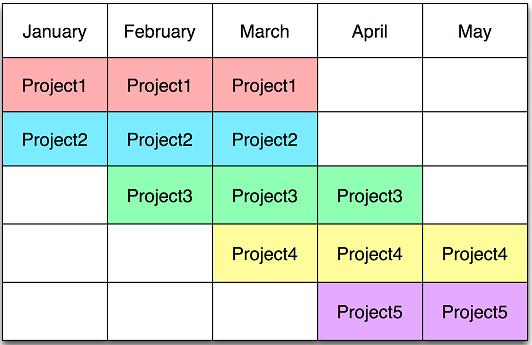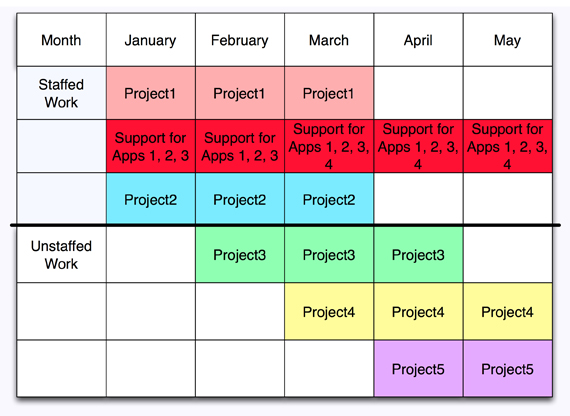When people begin to get overworked, it's common to fall back on blaming the old chestnut "time management." But the problem may have less to do with how you allocate time to projects than your inability to say no to some of those projects in the first place. In this article, Johanna Rothman takes a look at the difficulty of saying no and offers some suggestions for overcoming it.
Pat meets me in the lobby and walks me to the conference room for our 9 a.m. meeting. She yawns several times during our two-minute walk. She yawns a few more times before everyone else arrives.
"Late night?" I ask.
"They're all late," she replies. "I'm way overworked."
When I asked why, she says, "I'm good at what I do, so my boss asks me to do more. Now I'm overloaded, tired, and not making the progress I could. I must not be managing my time well. Do you know of a good time management tool?"
Managing time—or managing action, as David Allen, author of Getting Things Done, might say—only goes so far. Pat's real problem is that she has too much to do. So do her developers and testers. Everyone in her department is overworked, tired, and cranky. That's because no one knows how to say no to more work.
In some organizations, it's a badge of honor to get more work. I know of several organizations where the senior managers say, "The reward for good work is more work." Harder work might be a good idea. Different work might be a nice reward. But more work—without realizing the costs of multitasking—is not a reward. More work creates death march projects and tired people who make mistakes.
Why Some People Can't Say No
Some people can't say no and make it stick because they feel bad when they try. I've heard many reactions to my nos. One manager told me I wasn't a team player. Once, when I thought I was being a team player by explaining what I could commit to and what I could not, a manager told me I was being a slacker. No one likes hearing that your manager considers you a slacker or not a team player.
Another manager told me, "I'll get someone else to do this work," to which I replied, "Good! I'm too busy to do this."
"But I was trying to guilt you into doing the work," he said. Many people fall for that guilt.
One manager said, "But I know you can do the work. I have faith in you!" I replied that faith was a great thing, but did he want to bet the projects' success on faith? This conversation was not career enhancing. For some managers, trying to have that conversation may even be career limiting, which is why some people have trouble making their nos stick.
Pat doesn't have these problems with managers' reactions, because she hasn't said no. "I would feel as if I'm letting my team and managers down," she says.Ways to Say No
If you feel you can't say no, you can say "when." One way to say when is to show the requestor your project portfolio and say, "Here's when I can start this work." Once you have a project portfolio, you can even ask, "What should I stop doing?"
Pat's original project portfolio looks like figure 1. You can see that Pat and others are working on several projects at once.
Month/Person | January | February | March | April | May |
Sally | Project1, support for App1, | Project1, support for App1, | Project1, support for App1, | ? | ? |
Steve | Project 1, support for app3 | Project 1, support for app3 | Project 1, support for app3 support for app4 | ? | ? |
Simon | Project 1, support for app2, | Project 1, support for app2, | Project 1, support for app2, support for app3 | ? | ? |
Tristan | Project 2, support for app1, | Project 2, support for app1, | Project 2, support for app1, | ? | ? |
| Topher | Project 2, support for app3, | Project 2, support for app3, | Project 2, support for app3, | ? | ? |
| Ted | Project 2, support for app2, | Project 2, support for app2, | Project 2, support for app2, | ? | ? |
Juan | Project 2, support for app1, support for app4 | Project 2, support for app1, | Project 2, support for app1, | ? | ? |
Jeanine | Project 1, support for app1, | Project 1, support for app1, | Project 1, support for app1, support for app4 | ? | ? |
| Pat | Management | Management, Project 3?? | Management, Project 3?? | ? | ? |
Figure 1: Pat's portfolio
Pat does her best to help everybody take on new work (projects 1 and 2) while still assigning everyone some support. It's difficult to predict how much support each application will require, so she assigns everyone some support work. She has no idea how to staff project 3, so she does the work on that project for a while.
Note that Pat makes it difficult for people to work together to finish work jointly. Each person has a different set of new work (project 1 or 2) and a different set of support work. That means people can't work together. If they need to talk to someone, that will always be an interruption and cause multitasking.
 |
Figure 2: What Pat's manager thinks her portfolio looks like
Pat's manager thinks her portfolio looks like figure 2. It's common for senior managers to have a simplified view of the project portfolio and to think the project team can get more work done. Notice that Pat's manager doesn't realize that Project3, Project4, and Project5 are all unstaffed. And, Pat's manager doesn't know about the support work. Managers may well forget all about the support that many development teams (developers, testers, analysts, writers, whomever) have unless the support work is not done.In reality, Pat's project portfolio looks like Figure 3.
 |
Figure 3
Once Pat has a picture of all the work in her group, she can have a conversation about which work to staff and which work to say no to. And, she can build a more realistic picture of the overall project portfolio with her peers so their boss can see what they are really doing.
When Pat shows her manager her portfolio, he says, "I had no idea you were working on all those projects. What's this business with support?" Now, they can have a conversation about all the work she and her team are trying to complete.
After discussing her current portfolio with her manager, Pat decides to tackle the "no" problem. "What would you say if I said no to more work?"
"Well, I'd think you were turning me down for a good reason. I'd probably want to see how people are allocated, to make sure everyone is working on the most important work. But I wouldn't fire you over a no."
Now, Pat and her manager meet biweekly to discuss how everyone is assigned to projects and for how long. Everyone is working on just one project during a week, and people are taking turns on the support work. She's also queued up the support work so team members don't have to interrupt what they are doing to manage it.
No is not easy to say in the organization, but it is necessary. Try showing your manager your work and explaining when you can get to new work. You are being a team player, you're not a slacker, you don't have to feel guilty, and you are certainly not letting anyone down.
You may be pleasantly surprised to have your well-defended no accepted.


User Comments
<span style="color: black; line-height: 115%; font-family: 'Verdana','sans-serif'; font-size: 7.5pt;">One of the cool things about Agile is you never need to 'no', just say yes and add the story to the backlog. Where the team has both forward development and maintenance responsibility, Kanban can valuable for managing the WIP limit. Either way Pat, needs to manage the flow and achieve sustainability for all involved.</span>